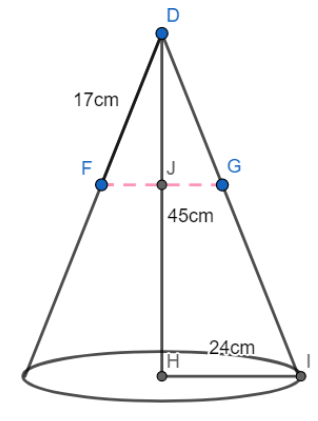
From the top of a cone of base radius 24cm and height 45cm a cone of slant height 17cm is cut off. What is the volume of the remaining frustum of the cone?
Answer
573.6k+ views
Hint: Assume that the height of the cone cut from the larger cone be h and radius be r. Use the fact that the triangle formed by the slant height, radius, and height of the smaller cone and the triangle formed by the slant height, radius, and height of the larger cone is similar. Hence find the value of h and r and hence find the height and the radii of the frustum of a cone. Use the fact that the volume of frustum of cone of height h and radii ${{r}_{1}}$ and ${{r}_{2}}$ is given by $V=\dfrac{1}{3}\pi h\left( r_{1}^{2}+{{r}_{1}}{{r}_{2}}+r_{2}^{2} \right)$. Hence find the volume of the frustum of the cone.
Complete step-by-step solution:

We have DH = height of the larger cone = 45cm
HI = radius of the larger cone = 24cm
DG = slant height of the smaller cone = 17cm.
We know that $l=\sqrt{{{r}^{2}}+{{h}^{2}}}$, where l is the slant height of a cone, r the radius of the cone, and h the height of the cone
Hence, we have $DI=\sqrt{{{24}^{2}}+{{45}^{2}}}=51$
Hence, we have DI = 51cm
In triangle DJG and DHI, we have JG || HI.
Hence, we have
$\angle DJG=\angle DHI$(Corresponding angles)
$\angle DGJ=\angle DIH$(Corresponding angles)
Hence by AA similarity, we have
$\Delta DJG\sim\Delta DHI$
Hence, we have
$\begin{align}
& \dfrac{DJ}{DH}=\dfrac{JG}{HI}=\dfrac{DG}{DI} \\
& \Rightarrow \dfrac{DJ}{45}=\dfrac{JG}{24}=\dfrac{17}{51}=\dfrac{1}{3} \\
\end{align}$
Hence, we have
$\dfrac{DJ}{45}=\dfrac{1}{3}\Rightarrow DJ=15$ and $\dfrac{JG}{24}=\dfrac{1}{3}\Rightarrow JG=8$
Hence, we have
DJ = 15cm and JG = 8cm.
Hence for the remaining frustum of cone, we have
$h=45-15=30,{{r}_{1}}=24,{{r}_{2}}=8$
We know that the volume of the frustum of cone of height h and radii ${{r}_{1}}$ and ${{r}_{2}}$ is given by
$V=\dfrac{1}{3}\pi h\left( r_{1}^{2}+{{r}_{1}}{{r}_{2}}+r_{2}^{2} \right)$
Hence, we have
$V=\dfrac{1}{3}\times \dfrac{22}{7}\times 30\left( {{24}^{2}}+24\times 8+{{8}^{2}} \right)=26148.57$ cubic centimetres.
Note: Alternatively, we can find the volume of the frustum of the cone by subtracting the volume of the smaller cone from the volume of the larger cone.
Hence, we have
$\begin{align}
& V=\dfrac{1}{3}\pi r_{1}^{2}{{h}_{1}}-\dfrac{1}{3}\pi r_{2}^{2}{{h}_{2}} \\
& =\dfrac{1}{3}\times \dfrac{22}{7}\left( {{24}^{2}}\times 45-{{8}^{2}}\times 15 \right)=26148.57 \\
\end{align}$
Which is the same as obtained above.
Complete step-by-step solution:

We have DH = height of the larger cone = 45cm
HI = radius of the larger cone = 24cm
DG = slant height of the smaller cone = 17cm.
We know that $l=\sqrt{{{r}^{2}}+{{h}^{2}}}$, where l is the slant height of a cone, r the radius of the cone, and h the height of the cone
Hence, we have $DI=\sqrt{{{24}^{2}}+{{45}^{2}}}=51$
Hence, we have DI = 51cm
In triangle DJG and DHI, we have JG || HI.
Hence, we have
$\angle DJG=\angle DHI$(Corresponding angles)
$\angle DGJ=\angle DIH$(Corresponding angles)
Hence by AA similarity, we have
$\Delta DJG\sim\Delta DHI$
Hence, we have
$\begin{align}
& \dfrac{DJ}{DH}=\dfrac{JG}{HI}=\dfrac{DG}{DI} \\
& \Rightarrow \dfrac{DJ}{45}=\dfrac{JG}{24}=\dfrac{17}{51}=\dfrac{1}{3} \\
\end{align}$
Hence, we have
$\dfrac{DJ}{45}=\dfrac{1}{3}\Rightarrow DJ=15$ and $\dfrac{JG}{24}=\dfrac{1}{3}\Rightarrow JG=8$
Hence, we have
DJ = 15cm and JG = 8cm.
Hence for the remaining frustum of cone, we have
$h=45-15=30,{{r}_{1}}=24,{{r}_{2}}=8$
We know that the volume of the frustum of cone of height h and radii ${{r}_{1}}$ and ${{r}_{2}}$ is given by
$V=\dfrac{1}{3}\pi h\left( r_{1}^{2}+{{r}_{1}}{{r}_{2}}+r_{2}^{2} \right)$
Hence, we have
$V=\dfrac{1}{3}\times \dfrac{22}{7}\times 30\left( {{24}^{2}}+24\times 8+{{8}^{2}} \right)=26148.57$ cubic centimetres.
Note: Alternatively, we can find the volume of the frustum of the cone by subtracting the volume of the smaller cone from the volume of the larger cone.
Hence, we have
$\begin{align}
& V=\dfrac{1}{3}\pi r_{1}^{2}{{h}_{1}}-\dfrac{1}{3}\pi r_{2}^{2}{{h}_{2}} \\
& =\dfrac{1}{3}\times \dfrac{22}{7}\left( {{24}^{2}}\times 45-{{8}^{2}}\times 15 \right)=26148.57 \\
\end{align}$
Which is the same as obtained above.
Recently Updated Pages
Two men on either side of the cliff 90m height observe class 10 maths CBSE

What happens to glucose which enters nephron along class 10 biology CBSE

Cutting of the Chinese melon means A The business and class 10 social science CBSE

Write a dialogue with at least ten utterances between class 10 english CBSE

Show an aquatic food chain using the following organisms class 10 biology CBSE

A circle is inscribed in an equilateral triangle and class 10 maths CBSE

Trending doubts
Why is there a time difference of about 5 hours between class 10 social science CBSE

Write a letter to the principal requesting him to grant class 10 english CBSE

What is the median of the first 10 natural numbers class 10 maths CBSE

The Equation xxx + 2 is Satisfied when x is Equal to Class 10 Maths

Which of the following does not have a fundamental class 10 physics CBSE

State and prove converse of BPT Basic Proportionality class 10 maths CBSE




